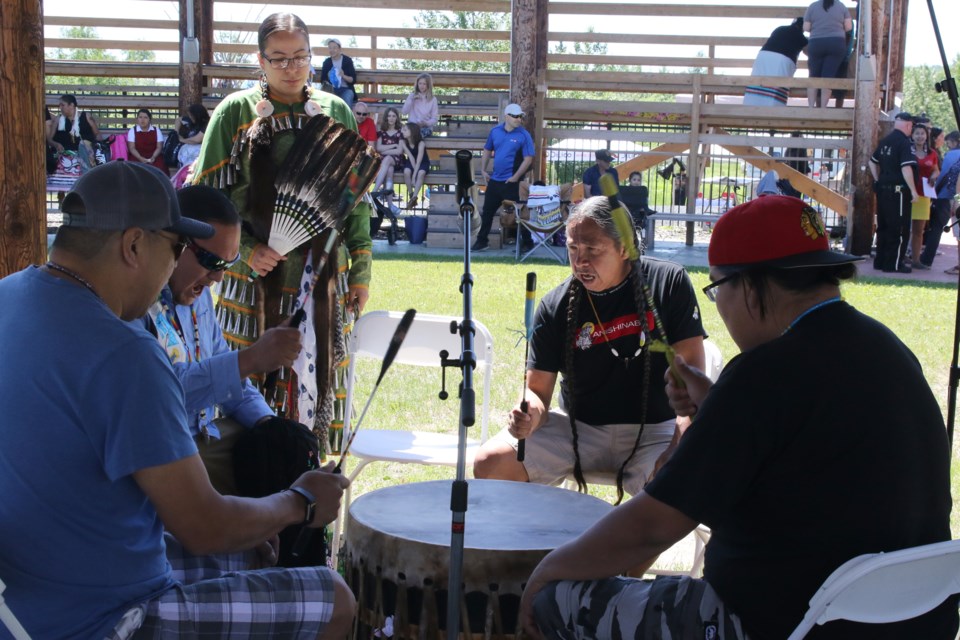For First Nations Peoples, the drum represents Mother Earth and her universal heartbeat. It facilitates the ability to “listen to our soul so we can understand our purpose and our connection to each other in the Circle of Life.”
The first sound that was heard in the world according to First Nations Peoples is the sound of the heartbeat of Mother Earth and this sound is one that they manifest through playing a special rhythm on the drum.
Indigenous culture and tradition believe that the rhythm facilitates healing and realignment of the four realms of human existence: mental, spiritual, emotional and physical, because the “Creator revolves around the rhythm.”
The drum is female and human and was first given to men by women so that men could experience a “resonant connection to the Earth Mother”, that occurs naturally with women. It is believed therefore, that First Nations drums are not percussion instruments, rather, they are female and human because of their tie to the earth. For First Nations Peoples, the drum is a constant reminder of our responsibility towards the preservation and health of Mother Earth.
Indigenous tradition teaches that song and dance is sacred and that just like humans each drum has its own unique voice. Because language and music styles vary from region to region across Canada and from the many First Nations communities within Canada, the geography and surroundings differ. Consequently, since stories and songs and traditions that reflect their history, and beliefs, ultimately their drumming will differ.
What remains a constant however is the significance of drumming to First Nations Peoples. For them, the drum, when combined with their voice, creates a “hum that rests between the voice and the drum in such a way that it is the spirits of the Ancestors.”
To understand the meaning, dynamics and significance of drumming, you need to learn about several components of drumming. These include: The Voice of the Drum; Ownership of the Drum and Drum Etiquette; The Magic of Drumming Circles; and Messages from the Drum.
The Voice of the Drum
According to Indigenous tradition, each drum has its own unique voice and vibration. As well each animal from which the drum is made of has its own unique medicine, “its spirit is part of the drum.” In order to give a drum its voice it needs to be “birthed” in a sacred ceremony. Belief indicates that until their traditional Drum Birthing Ceremony takes places the drum should not be played. During this ceremony, the drum is first dedicated to the Creator.
The drum is believed to be a sacred object and how it is stored reflects that because it is kept in a bag made of natural materials such as animal hide. The drum is also placed skin side up as a sign of respect. Each time the drum is used prayers are said to ask “the Creator for the ability to sing in a good way, to thank the Creator for the animal that gave its life to be the hide for the drum, and for the people who hear.”
Ownership of the Drum and Drum Etiquette
It is believed that the drum is the property of the individual who made it, purchased it or traded for it, had it given to them as a gift or prayed for it. If the drum belongs to a person, then permission must be given by that individual for anyone else to use it.
The Magic of Drumming Circles
Drumming circles bring people together and connect them to create unity and just be together. It helps to reduce stress, and during drumming, “natural bio-chemical in the body are released which help boost the immune system, among other things.” A peaceful meditative state is often the result, as the drum connects with the individual’s heartbeat.
Messages From the Drum
The tradition and significance of Drumming carries with it many important messages. Messages from the drum are related to creation, equality and peace, and spiritual, mental, emotional and physical balance.
Some examples of messages from the drum are:
I am Mother Earth’s heartbeat and the sacred gift of Creation.
I am the universal heartbeat of the seen and unseen worlds.
I put the drummer in touch with creation itself.
I speak to all people equally and peacefully.
I fulfill and create spiritual, mental, emotional and physical balance.
I am a powerful non-verbal form of peaceful communication.
I am the practice of peace.
I am renewal, re-growth and fulfillment.
I am the pulse of the universe.
Locally there are several Elders, who participate in drumming as leaders, and who offer their wisdom and talents to Indigenous youth, in their way of promoting their culture, language, traditions and teachings.
One individual, Elder Beatrice Twance-Hynes, offers teaching on the medicine wheel, the Sacred medicines, and the Seven Sacred Grandfathers, the hand drum. She is an “Elder in Residence” with Lakehead University, specifically their Aboriginal Cultural and Support Services. Beatrice is described as a “traditional women’s dancer, who makes her own regalia. She is a grandmother pipe carrier, a sacred circle facilitator, songwriter, singer and drummer.”
Drumming is certainly an integral part of Indigenous culture, tradition and teachings. It continues to be a part of the daily life of Indigenous peoples, reminding them that, the DRUM is a constant reminder of our responsibility to the preservation and health of Mother Earth.



